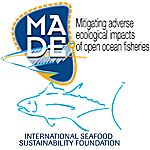Bomb derived radiocarbon from nuclear testing in the atmosphere provides one of the best age validation approaches available for long-lived fishes. Vertebrae from two blue sharks caught in 1986 and 1983 were sectioned, aged and assayed for 14C content in particular annuli. The shark caught in 1986 was too young for detailed assay: estimated age 17-19 years. This was confirmed by post-bomb 14C concentration in the 1-2 annuli. The age of the blue shark caught in 1983 was estimated at 26 years. 14C chronology obtained from assays of series of annuli showed offset from reference chronologies of about 3 years. Second independent reading of sectioned vertebra brought an agreement between two readers 22 years. The shark was also too young for definitive validation. However adjusted 14C curve for this individual demonstrate good agreement with Indian Ocean reference chronologies. This study shows that the assumption of annual formation of growth bands on Indian Ocean blue shark vertebrae is correct and age interpretation is relatively accurate. However further studies are necessary to obtain validation of blue shark ageing using the 14C method. Another archival georeferenced and size referenced vertebra(e) from big blue shark caught in early 1980s is needed to obtain definitive validation of age estimates.
- Presentation

 PDF version
PDF version
